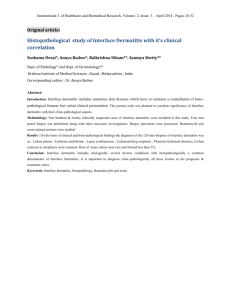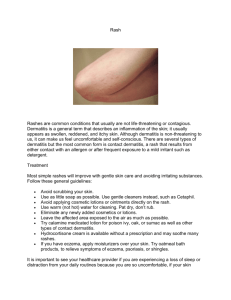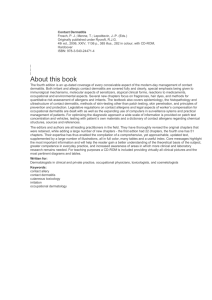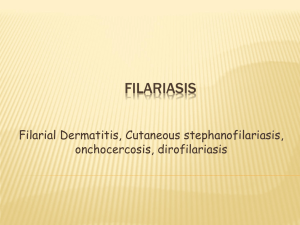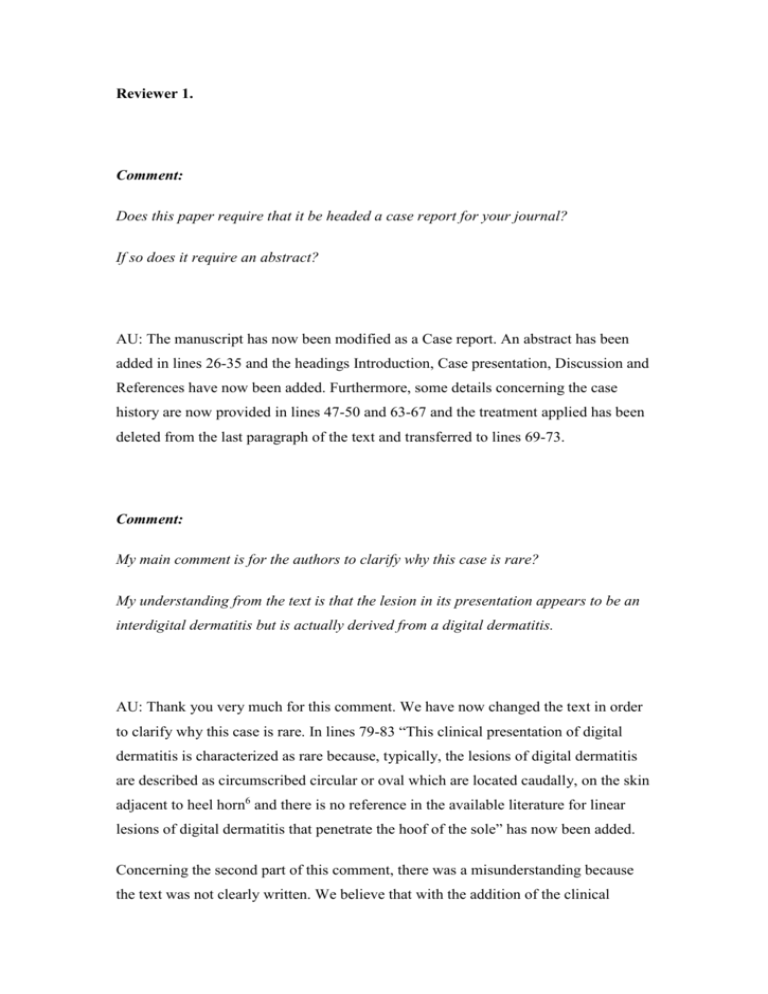
Reviewer 1.
Comment:
Does this paper require that it be headed a case report for your journal?
If so does it require an abstract?
AU: The manuscript has now been modified as a Case report. An abstract has been
added in lines 26-35 and the headings Introduction, Case presentation, Discussion and
References have now been added. Furthermore, some details concerning the case
history are now provided in lines 47-50 and 63-67 and the treatment applied has been
deleted from the last paragraph of the text and transferred to lines 69-73.
Comment:
My main comment is for the authors to clarify why this case is rare?
My understanding from the text is that the lesion in its presentation appears to be an
interdigital dermatitis but is actually derived from a digital dermatitis.
AU: Thank you very much for this comment. We have now changed the text in order
to clarify why this case is rare. In lines 79-83 “This clinical presentation of digital
dermatitis is characterized as rare because, typically, the lesions of digital dermatitis
are described as circumscribed circular or oval which are located caudally, on the skin
adjacent to heel horn6 and there is no reference in the available literature for linear
lesions of digital dermatitis that penetrate the hoof of the sole” has now been added.
Concerning the second part of this comment, there was a misunderstanding because
the text was not clearly written. We believe that with the addition of the clinical
history of the case in lines 47-50 and the statement in lines 76-77 “The case presented
here was classified as digital dermatitis based on the observation of the initial lesion”
it is clear that this lesion is a digital dermatitis lesion
Comments:
There also appears to be a big problem with definitions here- if the authors are
classifying interdigital and digital dermatitis differently this makes no sense in the
paper in its current form.
and
Papillomatous Digital dermatitis (PDD) is caused by a variety of bacteria
(treponemes included) and is also called Digital dermatitis, Interdigital
papillomatosis, and verrucous dermatitis (R.L. Walker et al). Merck manual does list
interdigital and digital dermatitis separately. Interdigital dermatitis appears less
severe, however both diseases can be caused by the same conditions and bacteria and
can occur concurrently. It seems logical that this difficulty in classification would
occur in severe or longstanding cases of digital/ interdigital dermatitis. Therefore can
the authors clarify the differences between digital and interdigital dermatitis and use
a reference for this.
AU: The text has now been modified in order to make clear the differentiation
between digital and verrucose form of interdigital dermatitis. In lines 93-97
“Verrucose dermatitis, a chronic process of interdigital dermatitis is believed to be
clinically indistinguishable to proliferative type of digital dermatitis, when the latter is
located proximal to the interdigital cleft7. However at the present case the lesion did
not involve the interdigital space and had started from the digital skin.” has now been
added.
Comment:
Authors could discuss more the probable cause of this case and how that relates to its
unusual or rare presentation. i.e. is this cow heavily pregnant on a wet faecal
contaminated concrete floor???
AU: Thank you for your helpful comment. The probable cause of this condition is
now discussed in lines 85-90: “The predisposing factors for this type of lesion are
unknown. The incomplete initial treatment at the erosive stage of the lesion as well as
the poor hygiene of the farm are considered the most possible ones. It is well known
that lesions of digital dermatitis if left untreated may persist for months. The poor
hygiene of the farm might not only have delayed the healing process but also have
contributed to the exacerbation of the lesion.”
Reviewer 2.
The editing comments have all now been adopted. Thank you very much.
Comment:
Are you saying this case is unusual because it looks like interdigital dermatitis but is
digital dermatitis and this is because of the appearance of the lesion???
AU: Thank you for this comment; the text has now been changed in order to clarify
why this case is rare. In lines 79-83 “This clinical presentation of digital dermatitis is
characterized as rare because, typically, the lesions of digital dermatitis are described
as circumscribed circular or oval which are located caudally, on the skin adjacent to
heel horn6 and there is no reference in the available literature for linear lesions of
digital dermatitis that penetrate the hoof of the sole” has now been added. The
addition of the clinical history of the case in lines 47-50 and the statement in lines 7677 “The case presented here was classified as digital dermatitis based on the
observation of the initial lesion” clarify why this lesion is characterized as digital
dermatitis.
©1996-2008 All Rights Reserved. Online Journal of Veterinary Research. You may not store these pages in any form except
for your own personal use. All other usage or distribution is illegal under international copyright treaties.Permission to use
any of these pages in any other way besides the before mentioned must be gained in writing from the publisher. This article
is exclusively copyrighted in its entirety to OJVR publications. This article may be copied once but may not be, reproduced or
re-transmitted without the express permission of the editors. Linking: To link to this page or any pages linking to this page
you must link directly to this page only here rather than put up your own page.
A RARE CLINICAL PRESENTATION OF DIGITAL DERMATITIS IN A
DAIRY COW
P.D. Katsoulos*, G. Christodoulopoulos
P.D Katsoulos: DVM, PhD, Clinic of Medicine, School of Veterinary Medicine,
University of Thessaly, Karditsa, Greece
G. Christodoulopoulos: DVM, PhD, Clinic of Medicine, School of Veterinary
Medicine, University of Thessaly, Karditsa, Greece
*Corresponding author:
P.D. Katsoulos
Clinic of Medicine
School of Veterinary Medicine
University of Thessaly
PO Box 199
43100 Karditsa
Greece
E-mail address: pkatsoul@vet.uth.gr
Tel: +30 2441066056
Fax: +30 2441066055
ABSTACT?
A rare case of digital dermatitis was observed during an investigation into the
prevalence of lameness in Greek dairy herds. Digital dermatitis is an important
disease of cattle, known worldwide, and has recently been reported in Greece1.
Typically, the disease is presented as painful, erosive ulcerations of the limb, usually
located on the skin of the posterior aspect of digits, proximal to the interdigital cleft,
and midway between the heel bulbs2,3. It is regarded as a significant cause of
lameness and poor welfare4,5.
During the former investigation, a primiparous dairy cow (age/ Breed?) was evaluated
because of reluctance to bear weight on her right hind-limb. The limb was moderately
asymmetrically swollen at the inner digit. After washing and trimming of the claws
the lesion presented in Figure 1 was observed. It was a linear proliferative-type lesion
that started from the skin of the posterior aspect of the inner digit of the right hindlimb above the heel bulb and, following the axial surface of the digit, penetrated into
the hoof of the sole, just in front of the heel bulb. The lesion was intensively painful
in touch, especially near the sole, and bled easily. The bacteriological examination of
a skin biopsy revealed the presence of Treponeme-like organisms. Heel-horn erosions
in both claws were also observed.
The proliferative type of digital dermatitis and verrucose dermatitis, a papillomatous
process thought to be a chronic process of interdigital dermatitis, are believed to be
clinically indistinguishable6. However, this lesion was classified as digital dermatitis
because it started from the skin above the heel bulb, without involving the interdigital
skin. This is because a readily recognizable healing process has started at that point
with the formation of a scab. Although spirochaetes of the genus Treponema are
considered causative agents for digital dermatitis7, the detection of these organisms
can not be used to differentiate digital and interdigital dermatitis because they have
been isolated from interdigital dermatitis lesions as well8.
The differential diagnosis further included interdigital necrobacillosis and white-line
disease. Interdigital necrobacillosis primarily involves the interdigital skin and is
characterized by diffuse symmetrical digital swelling9. Although at the present
condition there was swelling, it was moderate and asymmetrical and is attributed to
the injury of the corium. White-line disease may cause asymmetrical swelling of the
limb but it is an ascending infection that starts from the abaxial and seldom from the
axial white line9.
Heel-horn erosions, apart from the prolonged contact with manure, have been
associated with infectious diseases of the digit such as interdigital10 or digital
dermatitis11. It is believed that the presence of heel-horn erosions in both digits at the
present case is a consequence of digital dermatitis as it was found that there is a strong
correlation between heel-horn erosions and digital dermatitis11.
For the treatment of this condition a wooden block was applied to the sound claw and
oxytetracyclin spray was applied topically once a day for seven days. Furthermore,
the cow was injected with ceftiofur (2.2 mg/kg) once a day for seven days. Two
weeks after the onset of the treatment, the locomotion of the animal was improved
and the lesion had almost disappeared.
REFERENCES
1. Katsoulos PD, Filiousis G, Christodoulopoulos G: First report of digital
dermatitis in Greece. 24th World Buiatrics Congress. CD of Keynote lectures
& Oral and Poster communications (Nice, France), 2006
2. Bassett HF, Monaghan ML, Lenhan P, Doherty ML, Carter ME: Bovine
digital dermatitis. Vet Rec 126:164-165, 1990.
3. Blowey RW, Sharp MW: Digital dermatitis in dairy cattle. Vet Rec 122:505508, 1988.
4. McLennan M, McKenzie RA: Digital dermatitis in a Friesian cow. Aust Vet J
74:314-315, 1996
5. Read DH, Walker RL: Papillomatous digital dermatitis (footwarts) in
California dairy cattle: Clinical and gross pathology findings. J Vet Diagn
Invest 10:67-76, 1998
6. Greenough PR, Weaver ID: Lameness in cattle, 3rd edition. Saunders,
Philadelphia, PA, 1997
7. Dhawi A, Hart CA, Demirkan I, Davies IH, Carter SD: Bovine digital
dermatitis and severe virulent ovine foot rot: A common spirochaetal
pathogenesis. Vet J 169:232-241, 2005
8. Walker RL, Read DH, Loretz KJ, Nordhausen RW: Spirochetes isolated from
dairy cattle with papillomatous digital dermatitis and interdigital dermatitis.
Vet Microbiol 47:343-355, 1995
9. Weaver AD, Jean GS, Steiner A: Bovine surgery and lameness, Blackwell
Publishing Ltd, Oxford, 2005
10. Somers JGCJ, Frankena K, Noordhuizen-Stassen EN, Metz JHM:
Risk
factors for interdigital dermatitis and heel erosion in dairy cows kept in cubicle
houses in The Netherlands. Prev Vet Med 71:23-34, 2005
11. Manske T, Hultgren J, Bergsten C: Prevalence and interrelationships of hoof
lesions and lameness in Swedish dairy cows. Prev Vet Med 54:247-263, 2002
Figure 1. Linear proliferative-type lesion of digital dermatitis starting from the skin
of the posterior aspect of the inner digit of the right hind-limb and penetrating into the
hoof of the sole. Heel-horn erosions in both claws are also observed.

